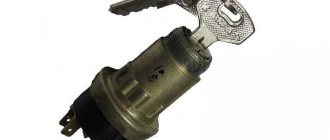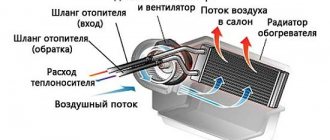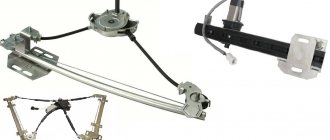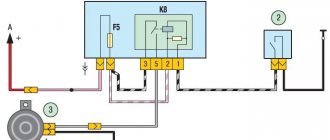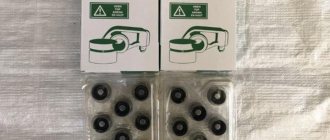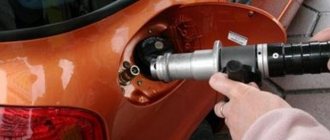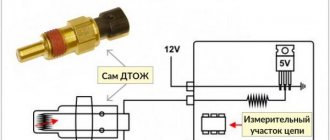After repairing the steering rack, the steering wheel turns hard: what to do?
If, after repairing the steering rack, the steering wheel begins to turn tightly, this may indicate an overtightened shaft nut. Service technicians recommend waiting 2-3 days, justifying this by the fact that the new mechanisms have not yet been used.
Tight steering wheel: reasons
Let's look at the main reasons why the steering wheel may be difficult to turn:
- nut is overtightened;
- The power steering pump is not working correctly;
- air got into the niches of the hydraulic booster;
- non-original power steering oil was poured into the service station.
The steering shaft of a modern car is mounted on bearings - both on the upper and lower sides. On the side there is a thrust nut responsible for tensioning the entire rack. When the nut is rotated with a wrench, the shaft is pressed against the lower bearing.
Tightening the nut causes the gear to be firmly engaged and the steering wheel to rotate tightly.
In this case, you need to loosen the thrust element so that the rack will work normally again.
Uneven wear on the shaft also makes the steering wheel difficult to turn. Wear causes the mechanism to jam. A characteristic sign: the “steering wheel” rotates either normally or poorly.
Any rack is adjusted in the extreme position of the steering wheel on the long side - in the extreme left position. It should be tightened so that the steering wheel rotates easily in both directions. First, it is recommended to tighten the nut all the way, then gradually loosen it by a quarter or half. After a full rotation, the steering wheel should automatically return to its original position.
Power steering pump problem
A stiff steering wheel is not always associated with a faulty rack. To check, just hang up the front wheels of the car, then turn the steering wheel. If it rotates normally, the problem is definitely not in the steering shaft.
Maybe the power steering pump was replaced incorrectly? And it began to produce a higher pressure than necessary - after all, a different oil was filled in. Due to the strong pressure, the liquid begins to flow out. In this case, the steering wheel has to be turned with force.
The problem is easy to fix. It is recommended to change the shaft along with the pump. This is the most effective solution, because the old will not work well with the new.
Air alert
Excess air in the system is not a big deal. The problem is easy to solve - you need to push out excess air from the reservoir and hydraulic niches. The stiffness of the steering wheel is explained by the fact that the system works with a liquid that contains bubbles.
Air may enter the system due to empty or damaged expansion tank. This can also be a consequence of improper repairs - the rubber bands were replaced, but the entire system was not checked.
Causes of rack noise
If a noise is clearly audible when the steering wheel is tight, you should know that this is a knocking sound from a loose steering tip sitting on the shaft rod. The knock may come from the steering rod joint, which rotates around the perimeter. The reason is backlash, large free movement.
The appearance of a knock may be due to the teeth of the steering shaft. When worn, they prevent the thrust nut from being fully tightened. In this case, it will not be possible to repair the rack; restoration is impossible.
The rack may not work well due to severe frost or sudden temperature changes. At minus temperatures, the rubber cuffs fail and oil begins to leak. The problem is solved by overhauling and updating the burst silent blocks.
If you have checked all possible causes and have not found a problem, and the steering wheel remains heavy, only replacing it with a new repair kit will help.
Steering rack
It is an integral part of the car's steering. It is to facilitate the movement of its elements, as well as steering rods, that power steering, electric power steering and other types of amplifiers were developed. The latter may or may not be installed on the machine.
In the latter case, the car is controlled only due to the driver’s physical impact on the steering wheel with the subsequent conversion of the rotational moment into the translational movement of the steering rods.
This transformation is carried out due to the gear rack, precisely because of the constriction of which it becomes difficult to turn the steering wheel.
The problem is easily solved by loosening the adjusting bolt, which is present on almost all steering racks or steering gears, such as, for example, in the VAZ 2105.
Let's look at specific examples.
VAZ 2105, 2106, 2107
The first thing you need to look at when on a VAZ 2105, 2106, 2107 and other cars from this model range, the steering wheel begins to turn tightly, especially with the front wheels hanging, is the steering gearbox (column).
By external inspection, make sure that there is no oil leakage through the seals in the unit. Check the transmission oil level in the gearbox through the filler (control) plug. Make sure the steering column is adjusted correctly and is not pinched.
The second thing to do is check the condition of the ball joints. There are four of them, two on each side, top and bottom. If they are worn out and there is play in them, then this can also affect the increase in effort to rotate the steering wheel.
Next, check to see if one or both ball joints are jammed. To do this, disconnect the steering tips from the column. This is done so that the steering knuckle can be rotated freely.
If it rotates heavily with a knocking noise, the ball joints are jammed and will have to be replaced.
Next, check the left and right pendulum arms for wedging; to do this, disconnect the steering rods from them and move them by hand. They should walk freely, without grinding. Otherwise, replace them. For example, they can jam due to misalignment of the nylon bushings.
It’s better to immediately replace the pendulums on bushings with an analogue with ball bearings. You will immediately feel how easier the steering wheel begins to turn.
Also check the tie rod ends for play. If new tips were installed, then it will be difficult to drive the car for some time until they develop and become easy to move.
Angle of inclination of the stand (caster).
It would seem that this has something to do with the caster and the tight steering wheel. As a rule, the angle of the strut (positive or negative) is set by the manufacturer, and it does not change during wheel alignment.
But there are situations when on VAZ classics 2101 - 2107 at the service this indicator is changed, for example, from 0 (factory) to 1. This leads to the fact that the steering wheel begins to rotate harder, but at the same time it returns to the zero position faster after completion turn.
If you drive around the city more, then cluster 0 is more preferable, since the steering wheel rotates easier with it, but it does not return to its original position as quickly.
With cluster 1, the opposite happens: the steering wheel turns hard, but returns quickly. This cluster is preferred by drivers who travel more outside the city.
Body geometry.
Few people know about this, but on old VAZ classics it is possible to change the body geometry. For this reason, the casters are disrupted and the steering wheel begins to turn tightly.
To solve this problem, find two washers 4 mm thick and place them in the lower arms on both sides, but only in those places that are on the driver and passenger sides, and not on the radiator side.
Thanks to this, the lever will be located at an angle in relation to the beam. Next, do the wheel alignment, the steering wheel should turn easier.
VAZ 2109 and other models
The steering rack is installed here. As a result of wear of its internal parts and an increase in the gap between them, over time it begins to knock. This also applies to other cars with the same type of steering, VAZ 2110, 2114, 2115, Lada Priora, Kalina, Granta, etc. The last three models already come with an electric power steering system.
Using a special adjusting bolt, the gap between the drive gear and the rack is reduced and the knocking stops.
But if you tighten the bolt, a situation will arise when the steering wheel turns tightly. Therefore, it is important not to overdo it here.
And further. It is important to understand that the rack itself wears out the most in its central part (moving straight). There is less wear on the edges (when turning). Therefore, when adjusting, the central part of the rack is pressed normally, but the edges are pinched. As a result, if the car is moving straight, the steering wheel turns normally, but when turning it is tight.
For the same reason, if the car has power steering, the load on the pump increases when turning. It is transmitted through the pulley and belt to the engine, which “sags,” i.e. loses power.
The way out of the situation is to loosen the bolt a little or replace the rail.
Other reasons:
- Worn bearings on the upper shaft of the steering column;
- Seized strut support or bearing;
- There is no lubrication in the steering rack.
Why is the steering wheel on a VAZ 2110 hard to turn?
Post by zhekasin » April 12, 2011, 5:11 pm
Messages: 157 Registered: July 28, 2007, 00:00 From: Tyumen Experience: since 2000
| Rating: 187 |
| Reputation: 0 |
Posted by carovec » April 12, 2011, 05:13 pm
Barguzin tires 13″ regular wheels
I drove it and this never happened
Messages: 23 Registered: 02 Sep 2010, 00:00 From: Tyumen Experience: 2007
| Rating: 23 |
| Reputation: 0 |
Post by zhekasin » April 12, 2011, 6:50 pm
Messages: 634 Registered: August 29, 2008, 00:00 From: Tobolsk/Tyumen Experience: 2004 Car: 407 coupe, Solaris :
Awards: 1
| Rating: 727 |
| Reputation: 0 |
Post by ser097 » April 12, 2011, 07:31 pm
Messages: 16 Registered: February 11, 2010, 00:00 From: Dzerzhinsky Experience: 2003 Car: 21140
| Rating: 16 |
| Reputation: 0 |
Message IL-14 » April 12, 2011, 8:23 pm
Messages: 215 Registered: Oct 20, 2008, 00:00 From: 72RUS Car: TAZ
| Rating: 365 |
| Reputation: +1 |
Thanked: 1 time
Post by KAMATO3 » April 12, 2011, 21:14
Messages: 157 Registered: July 28, 2007, 00:00 From: Tyumen Experience: since 2000
| Rating: 187 |
| Reputation: 0 |
Posted by carovec » April 13, 2011, 10:03 am
How do you know if the support bearings need to be replaced?
Messages: 14279 Registered: Dec 06, 2010, 00:00 From: Tyumen Center Experience: 1976 Car: really like it :
Awards: 2
| Rating: 98 035 |
| Reputation: +197 |
Thanked: 1007 times Thanked: 1208 times
Post by Grigoryich » April 13, 2011, 10:19
We will never get what we want until we are grateful for what we have!
Osim haim!
Messages: 216 Registered: Feb 18, 2010, 00:00 Experience: 2008
The steering wheel is hard to turn - what is the reason?
The steering system is a critical safety component for your vehicle. That is why you should carefully monitor the correctness of its operation and pay close attention to even the slightest changes in its normal operation. At the same time, a heavy steering wheel is one of the most common problems with the steering system; it causes a lot of inconvenience, especially for the female half of humanity, and can lead to quite expensive consequences.
Your vehicle's steering system is designed to allow you to steer the car where you want it to go. But today, the steering wheel is connected to the front wheels of the car through a number of units, passing through a rather large chain of them, where each link must work flawlessly so that every turn of the steering wheel results in a successful turn in the desired direction of the car’s wheels. Therefore, every time you turn the steering wheel, the front wheels also turn. And the moment when it becomes difficult for you to turn the steering wheel is very easy to notice. Continue reading below to learn about possible reasons why your steering wheel is turning significantly harder than usual.
Steering Chain Components
First of all, pay attention to the features of this malfunction:
- How much harder has the steering wheel become to turn: is it even possible to turn it while the car is standing or moving, or can it be turned only by making great or even enormous efforts?
- Does the problem occur when the car is accelerating or only when coasting, braking, or while the car is stationary with the engine running?
- Which power steering system is installed in your car: hydraulic or electric?
- Does the steering wheel turn hard all the time or at certain (chaotic or not?) moments?
All this will help you most accurately determine why the steering wheel has become difficult to turn. So let's take a look at all the possible causes of a heavy steering wheel in order and describe what symptoms plague our driving process!
Underinflated tires
And let's start with the most possible and most easily removable and diagnosable cause of heavy steering - with incorrect tire pressure, namely, with underinflated tires. The essence of the problem here is that due to the low level of pressure, the tire of the wheel becomes softer, as a result of which the contact area with the road surface increases, which, in turn, leads to the fact that such a wheel becomes harder to turn.
The main symptom of this reason is that the increase in the ability to turn the steering wheel in this case is barely noticeable, and most often even almost completely unnoticeable. However, if we are talking about SUVs or heavy crossovers with large wheels, then the steering wheel can become much harder to turn.
Just stop by your nearest tire shop and check the pressure in all four tires, as well as the spare tire on your car.
Power steering fluid level is too low
Like all other fluid levels in your car (coolant, anti-freeze, fuel, oil, etc.), it is necessary to check the power steering fluid as often as possible. Too low a power steering fluid level can result in heavier steering, or even no power steering at all.
Check the power steering fluid level - you can find it in a cylindrical reservoir (tank) near one end of the power steering line - under the hood, most often closer to the car interior, in the vast majority of cases in the form of a plastic (less often metal) tank with MIN and MAX marks, which correspond the minimum and maximum normal level of this fluid in the steering system. If the fluid level is below the minimum required level, this means that this is most likely the problem with the heavier steering wheel.
Power steering fluid reservoir with marks for heated and cooled fluid
If you need to add power steering fluid, you need to check its level again after a while - it is possible that your car has a leak of this fluid.
Power steering fluid has become unusable
If the power steering fluid level is normal (and even if it is below the minimum level), it is also necessary to check whether this fluid has become unusable and whether, as a result, it has ceased to perform its functions. It's easy to do. The normal color of power steering fluid is most often dark red (but can vary from this) - if the fluid has become too dark and cloudy, this most likely means it needs to be changed. If you have never done this, then it is better to entrust this matter to a professional, although you can replace the fluid yourself, having first studied the instructions for this procedure applicable to your car model. Remember that you must not allow air pockets to get into the system when replacing this fluid (it is also easy to determine the presence of such plugs - the liquid in the dacha will be foamy in this case).
Power steering
Most modern cars, for example, Chevrolet Lacetti, Volvo xc90, BMW e39 (not on all models), Renault Simbol, Gazelle GAZ-3302 (not on all models, the latter have an ESD) have been and continue to be installed with power steering. It is malfunctions in its operation that can lead to the fact that you will have to make a lot of effort to drive the car.
Oil level and condition
The first thing you should pay attention to if the steering wheel starts to turn tightly is the presence and condition of oil in the power steering reservoir. Its low level is the most likely cause of the problem. But you need to take into account that the level of heated liquid may differ from cold one.
It is important to find out why this happened:
- natural consumption (you just haven’t looked into the tank for a long time);
- leakage occurred as a result of wear or damage to sealing elements, hoses, etc.
If the oil level in the tank is minimal, then it is better to refuse further operation of the car in this situation, as this may lead to pump failure. As a last resort, you can remove the power steering drive belt and thus try to get there or call a tow truck.
Also pay attention to the condition of the oil, ask yourself - “When did you change it and what kind did you fill in?” There have been cases when simply replacing it solved the problem. But here it is important to fill in the oil prescribed in the operating manual for your particular car model, and not experiment.
Air in the system
Air can get into the booster hydraulic system for various reasons, the main one being improper replacement of the working fluid (oil).
It is clear that the presence of air bubbles in the system will negatively affect the transmission of forces as a result of a decrease in pressure, which will lead to tight rotation of the steering wheel.
To solve this problem, it will be sufficient to turn the steering wheel completely to the right and left several times with the engine running. This will renew all the oil in the expansion tank and squeeze out the air.
Power steering belt tension
Check the condition of the power steering drive belt. If it slips, which is often accompanied by a whistling sound, the pump will not create the required pressure in the system. For this reason, the steering wheel will turn tighter.
An overtightened belt will create an unnecessary load on the drive shaft and, accordingly, on the engine, thereby causing rapid wear of the bearing, reducing the efficiency of the pump and motor.
If the belt is tensioned correctly, but wears out noticeably quickly, then remove it from the pulley and turn it last. It should rotate freely without grinding or jamming. Otherwise, you will have to change the bearing.
The schematic diagram of tensioning the UAZ Patriot power steering belt is shown below.
Thick oil
In winter, if the steering wheel starts to turn hard, pay attention to the condition of the oil in the tank. If it has thickened greatly, it means it is not suitable for the given operating conditions.
Make sure that the fluid has been filled according to the car manufacturer's recommendations. If necessary, replace with another after consulting with specialists.
Anti-leak in power steering
Temporary restoration of the operation of the hydraulic booster is possible with the help of special sealants, which, due to their properties and the additives they contain, improve the operation of the power steering and eliminate leaks in the system.
But there is also the other side of the coin. Improper use or the use of counterfeit products leads to changes in the viscosity and other performance properties of the oil and, as a result, it may become thicker and you will have to make more effort to drive the car.
The problem is solved by replacing the oil and the reasons for its leakage, followed by eliminating the use of sealants.
Power steering filter clogged
Find out whether the power steering of your car model includes an oil filter, which is usually located in the tank. The first sign that it is clogged is when it becomes difficult to turn the steering wheel when the engine is not yet warmed up.
This happens because the still cold and viscous oil has a hard time passing through the filter. In the future, the problem disappears, since it is already heated and becomes more fluid.
Pressure regulating valve
The valve may stop working for many reasons, from simple blockage to piston misalignment as a result of mechanical stress on its body, for example, when replacing a pump.
If the pressure in the system has dropped, it is worth checking the condition of this valve.
Soon the end of the pump
Low pressure in the system with a normal oil level, correct drive belt tension, no kinks in the hoses, or a intact valve may indicate that the power steering pump is running at its limit as a result of wear of its parts. The problem can only be solved by repairing or replacing it.
Loss of engine power when turning
There are situations when the steering wheel starts to turn tightly only when turning, but when driving straight this problem does not arise. At the same time, the engine power “sags” when turning.
It's all about the steering rack. This topic is fully covered in the section about the VAZ 2109.
In some car models, tight rotation of the steering wheel is caused by other specific causes, for example, on the Volvo xc90 the problem can arise due to wear of the ring notches of the FO 044VALVE pressure reducing valve and the ellipse along which the rotor blades slide. Replacing the valve can save the situation without replacing the entire pump.
But the whole difficulty here is that the power steering will have to be removed. For ease of work, you will need a wrench with Torex 50.
The power steering is hard to turn: possible reasons. Power steering repair
Today, not a single car can do without power steering (power steering), the equipment of which was carried out with a focus on the modern level of driving comfort. The hydraulic mechanism facilitates physical control of the machine while maintaining optimal feedback and compliance with safety requirements.
This is achieved by introducing an auxiliary mechanism into the steering wheel system, the technical condition of which must be regularly monitored. If, after a certain time of using a machine with such equipment, deviations in the operation of the mechanism are noticed, then you should prepare for its repair. For example, if the power steering is hard to turn, there may be several options to resolve the situation. But first you should consider the design of the mechanism and the principle of its operation.
Electric power steering
Compared to power steering and electric power steering, the EUR is structurally simpler and therefore more reliable. It consists of an electric motor that is mounted directly on the steering column, a set of sensors and an ECU.
EUR is installed on most modern cars. Let's include domestic models - Lada Priora, Granta, Kalina, Niva (since 2009), the latest Gazelle models (GAZ 3302, 2705, 3221, 33023).
If the steering wheel on a car with electric power steering starts to turn tightly, check:
- Is the EUR indicator on the instrument panel lit? When the ignition is turned on, the lamp should light up and go out after the engine starts.
- Whether the speed sensor and speedometer work, they work synchronously with the power steering and are interconnected. The higher the speed, the less force is transmitted to the steering rack and vice versa;
- Is the torque sensor faulty?
- What is the voltage in the on-board network;
- The contacts of the 50 A power steering fuse have burned out or burned out. For example, on a Lada Priora it is located under the hood, shown in the diagram below.
If the problem persists, check the condition of the steering rack, support bearings, cardans, etc. All this has already been described above.
If your car's steering wheel starts to turn hard and you can't find the reason, ask questions in the comments, we will try to answer.
How does power steering work?
The hydraulic booster system is multi-component, but closed. This device is partly responsible for the difficulty of repairing the structure. A typical mechanism includes a pump, a reservoir with liquid in the form of a tank, a pressure regulator, a power unit and a spool. The pump is connected to the drive system of the machine’s engine, and the pressure regulator ensures that the force flow is balanced relative to the spool. The operating pressure difference depends on the supply of control fluid.
It is this part of the functionality that in most cases leads to problems that require power steering repair in the form of correcting the position of individual parts of the structure or by updating the oil. In turn, the hydraulic cylinder interacts with the steering rack, transmitting additional force. In order for the final load required to activate the steering wheel to be balanced, the spool itself is installed on the column - in the future it will react to the torque when the driver performs manipulations.
Causes of tight rotation
Now you need to figure out why the car steering wheel turns so hard, based specifically on units with power steering. These are the most common systems that cannot be called unreliable. Much depends on the attitude towards the car and the initial quality of the mechanism.
Most often, such situations are associated with the consequences of wear and tear of elements, untimely maintenance of the car, and extreme loads to which the driver subjects the car. With some knowledge and skills, problems can be diagnosed at an early stage. You can actually do this on your own or by contacting a car service center. The main thing is to prevent further deterioration of the situation and return the node to normal operation.
Practice shows that the main reasons why the steering wheel on a car becomes harder to turn are related to:
- tire pressure;
- wheel position;
- hydraulic booster;
- hydraulic pump;
- steering system components, etc.
One thing is clear: a tight steering wheel is not the norm for a modern car. All reasons should be considered separately and decided how to act in a given situation.
What are the signs that indicate a problem?
The feeling of heaviness when steering the steering wheel does not always appear suddenly and at once. This can be a long process, during which warning signs may arise. In particular, initial diagnostics will help detect problems due to the formation of leaks, noise and excessive vibrations. Over time, a tight steering wheel will be added to this list if the same leak is not stopped and the fluid supply is replenished. Of course, the above signs may also indicate the appearance of other problems, and not only with the hydraulic booster. Therefore, general diagnostics in this case will not be superfluous. It will also allow you to more accurately determine the possible cause of the weighting of the steering wheel.
The main reasons for a tight steering wheel
There are many factors that can lead to difficulty steering due to power steering. Each of them involves its own approach to repair. One of the most common reasons is the presence of air in the niches of the hydraulic booster. Its presence not only eliminates the main function of the mechanism, but also has the opposite effect, making the movements of the steering wheel heavier.
Another common reason is the aforementioned emptying of the expansion tank with liquid. If it was not possible to determine the reason why the power steering is difficult to turn, then it makes sense to turn to the technical condition of the individual components of the system. For example, wear of parts, especially the drive belt, could indirectly provoke a decrease in hydraulic function. In this case, a complete revision of the mechanism and, possibly, its replacement cannot be avoided. The possibility of a problem with the steering wheel itself should not be ruled out. For example, a rack connected to a gearbox can cause even more trouble in terms of repairs.
Steering wheel behavior is different when cold and hot
If the car's steering wheel behaves differently when leaving the garage and after a long drive, the reason may lie in a change in the characteristics of the steering elements.
There are two options for how the car behaves:
- When cold, the steering wheel is light, but after a short mileage it becomes heavier.
- When cold, the steering wheel turns hard, but after warming up everything is fine.
In the first case, we have a situation with linear expansion of materials. As a result of increasing temperature, some elements change their size. If tolerances and fits are not chosen optimally, then some elements may become jammed.
Read also: DIY hoverboat
To diagnose this situation, it is necessary to jack up the front of the car (if it is front-wheel drive) and turn the steering wheel when it is cold and hot. Wedging areas are usually detected by visual inspection.
In the second situation, usually the reason why the power steering is difficult to turn lies in the thickening of the oil. If this situation occurs in winter, then there is no particular cause for concern. But if this interferes with comfortable driving, it is recommended to replace the power steering fluid with a higher quality one.
When the car is cold all year round, the steering wheel may be difficult to rotate due to a clogged filter. Some power steering models have a built-in filter in the hydraulic system reservoir. Over time it becomes clogged with debris. Heated oil can pass through it unhindered, but on a cold car this causes problems.
How to disassemble a tight steering wheel?
To verify the reasons why the steering wheel could become heavier, you should disassemble the mechanism. The event begins with disconnecting the pipelines that lead to the expansion tank and steering system. At this point, you can drain the liquid. Next, the drive belt from the pump is removed - again, if it is in an unusable condition, then you will have to put on a new belt.
Here, three blocks for fixing the pulley suitable for the pump unit are unscrewed. But depending on the type of fastening system, there may be more. After this, access to the fixing elements of the pump itself may open. As you can see, power steering repair can be performed already at this stage by replacing the fluid, updating the hoses and the drive belt. But this may not be enough. Special attention should be paid to the filter system. Even if it performs its function properly, a violation at the cleaning stage is possible, which cannot be determined in a garage environment. Therefore, if there are no other obvious causes of the problem, it makes sense to have the filters checked in a professional workshop.
Getting rid of excess air
If the reason is the presence of excess air in the system, then in a sense we can talk about luck. True, everything here is ambiguous. Most often, this problem is solved by several turns of the steering wheel, brought to the stop. Moreover, this action is performed in both directions. As practice shows, this allows you to push out excess air from the hydraulic communications. But if even after this action the steering wheel turns hard, then the tank is more likely to become airy. This means that the system works with liquid in which bubbles are present. This factor determines the lack of ease of use of the steering wheel. A complete renewal of the fluid in the expansion tank will help eliminate this problem.
The steering wheel is tight, what should I do?
Defects accompanied by tight steering are a common occurrence for a wide variety of car models. A tight steering wheel creates discomfort and makes it difficult to control the car, which can be very unsafe. In this article, we will look at the main causes of problems in the steering system, and also identify the characteristic signs of malfunctions, one way or another, related to the problem when the steering wheel turns tightly.
Over-tightening
Often, inexperienced drivers try to tightly tighten the adjustment screws to eliminate large play in the steering wheel. In worm gearboxes, which are most often used on rear-wheel drive and all-wheel drive vehicles, the first step is to adjust the displacement of the bipod shaft along the axis of the steering unit shaft. On VAZ series models, by rotating the adjusting screw with a locknut, you can quickly eliminate play in the bipod shaft bearings.
Adjustments are made in a similar manner on many foreign cars. The common problem in such cases is the over-tightening of the tapered bearings that support the aforementioned shafts. To prevent the steering wheel from moving stiffly, it is necessary to rotate the adjusting screws until slight forces appear on the screwdriver or wrench used for calibration. Remember that with this type of bearing it is better to leave a little clearance than to overtighten it a little. Even the slightest tightening can lead to significant forces on the steering wheel.
Cracking sound when turning the steering wheel
For almost all modifications of the classic VAZ 2101 series, including 2103 and 2106, after replacing steering elements or performing repairs related to dismantling the above parts, a cracking sound may appear when turning the steering wheel. The main cause of this problem is the lack of alignment of the steering shaft in relation to the splined mating part of the shaft. To eliminate the malfunction, it is necessary to install special adjusting shims between the steering unit housing and the side member when installing the steering mechanism.
The steering wheel is hard to turn
Poor tension in the power steering pump drive belt may cause a decrease in pump performance. As a result, the steering wheel is difficult to turn. Poor belt tension can be determined by the characteristic sound. However, increased noise can also be caused by a decrease in the level of hydraulic fluid in the tank. Quite often, strong pump noise is a sign of failure of the pump itself.
If you notice a fluid leak from the power steering system and there is no way to top it up, experienced technicians recommend removing the drive belt to get to the repair site. Otherwise, even after a few minutes of running the pump without liquid, deep scoring may occur in the housing. This primarily applies to Toyota and Volvo cars, in which the power steering pumps are driven using a single V-belt. Their peculiarity is that even short-term operation of the engine in this mode can be fatal.
On some car models, an oil filter may be mounted in the power steering reservoir under the cap. For example, in Mercedes it is made of a toroidal shape. If it is dirty, additional forces on the steering wheel may also occur.
The steering wheel became difficult to turn
If, after performing repair work related to replacing the bushings of the pendulum assembly, the steering wheel begins to turn tightly, there may be two reasons. Firstly, the quality of the bushings themselves is unsatisfactory, so try to buy only original spare parts. Secondly, tighten the locknut.
For VAZ cars, excessive tightening of the bushings of the pendulum assembly from the ends during the replacement process is a completely natural phenomenon. This was especially true for classic models. Today you can buy sealed pendulum supports equipped with rolling bearings. They will help you avoid such troubles by making your car more manageable.
Steering wheel turns hard
One of the typical reasons for additional forces on the steering wheel may be strong clamping of the axle supports. For example, on older modifications of the Volga and most trucks, the steering wheel turns hard due to the lack of lubricants or a rigid (tight) fit of the pins in the standard bushings. Plus, in designs of this type, spontaneous rotation of this bushing can be quite common. As a result, the lubrication hole is displaced, making it impossible to pressurize the bearings.
For classic VAZ modifications, tight rotation of the steering wheel is most often the result of poor quality supports, flooded with polyamide (special plastic).
On classics these are mainly only the upper supports, but on Nivas, most often both upper and lower. As practice shows, even additional lubrication or running-in does not provide the desired result. There is only one way out, installing original components.
Ball lower bearings, equipped with metal inserts and installed from below, as a rule, rarely affect the appearance of additional forces. They usually fail in the absence of lubrication, which can be determined by the characteristic sounds when the car rocks. If you notice sharp clicks and the steering wheel does not return to the neutral position on its own after completing the maneuver, you need to notice the corresponding support.
Recommendations from the experts
If the performance of the power steering pump decreases, check the fluid quality level. If necessary, add or change oil.
If the fluid bypass valve is stuck, drain the oil and remove the valve. After washing, find out the cause of the malfunction and, if necessary, replace the part.
Fluid replacement
To do this, it is not necessary to completely disassemble the mechanism. First of all, you should free the two pipes leading to the expansion tank from the clamps. Also, if necessary, additional fasteners and belt communications are removed, which make access to the tank difficult.
The fluid can be directly replaced without completely dismantling the tank. The spent mixture is simply pumped out, after which all that remains is to pour in new auto chemicals. However, if the power steering steering wheel turns tightly and has not been checked for a long time, then it is advisable to dismantle the reservoir for subsequent diagnostics. It should be checked for leaks, then thoroughly washed and rinsed with clean water. The dried tank is installed in its place, filled with new working fluid and secured with fasteners.
Recommendations
Comments 7
replace the grease in the rack
symptoms of such a TIGHT STEERING COULD BE tire pressure, soured, dead ball joints, fucked up rack in the trash and the adjusting nut on it is screwed in. you may not see the balls, whether they are finished or they are alive only after removal, the adjustment nut, if you tighten it all the way, the steering wheel will spin like a penny. Take the key, check the tightness of the rack, tighten it all the way and loosen it by 45 degrees, that’s what they say in Murzilka if this doesn’t help, maybe the rack is full... try pumping up the slopes at 2.2 atm
I also have some play... and the dog is knocking... what and how should I change? hard?
I did everything according to the instructions from the internet. The problem is with two bolts that have round heads (threaded)
From this article you will learn why the steering wheel turns tightly, how to find out the cause of this malfunction and what to do in each of the possible cases.
Author of the article: mudriy_lev Specialization: repair of auto generators and servos in cars. Place of work: service center. Experience: 2 years. Education: higher education - electrical engineer, secondary specialized education - mechanical assembly mechanic.
For a number of reasons, the car owner may notice that the steering wheel has become difficult to turn. Because of this, you have to put extra force on the steering wheel, and as a result, you will not get enough pleasure from driving the car and a serious blow to road safety.
Read also: Hyundai Getz automatic gas mileage
Which liquid do you prefer?
The issue of choosing power steering fluid also imposes considerable responsibility. It is advisable to give preference to synthetic hydraulic mixtures made from high-quality components. Regular machine oil is not suitable in this case. Features of specialized compositions include a sufficient degree of fluidity, viscosity and the ability to work at extreme temperatures.
Often problems of this kind occur precisely in winter, when the filled liquid simply cannot cope with its tasks due to freezing. Therefore, the question of which oil should be poured into the power steering should only be decided in favor of special synthetic or semi-synthetic mixtures, which usually have a dark green tint. If we talk about manufacturers, high-quality auto chemicals of this type are produced by Motul, Castrol, Pentosin, Liqui Moly, etc. The cost of the liquid is about 800-1000 rubles, but even a small canister will last for a long time, so it’s not worth saving on this resource.
How to replace a heavy steering wheel?
Dismantling the system begins with the aforementioned disconnection of all pipelines, pipes and fasteners. It is also mandatory to drain or pump out the oil poured into the expansion tank. Installation of the new system is carried out in reverse order. If we are talking about a complete renovation of the steering complex, then in this case the rack itself will have to be dismantled. Such a replacement of the power steering must be carried out in conditions where there is an installation straightening stand. The installation begins with the integration of the steering wheel, and then the hydraulic components are integrated one by one. Lastly, the working fluid is filled in, and the communication elements are supplied.

